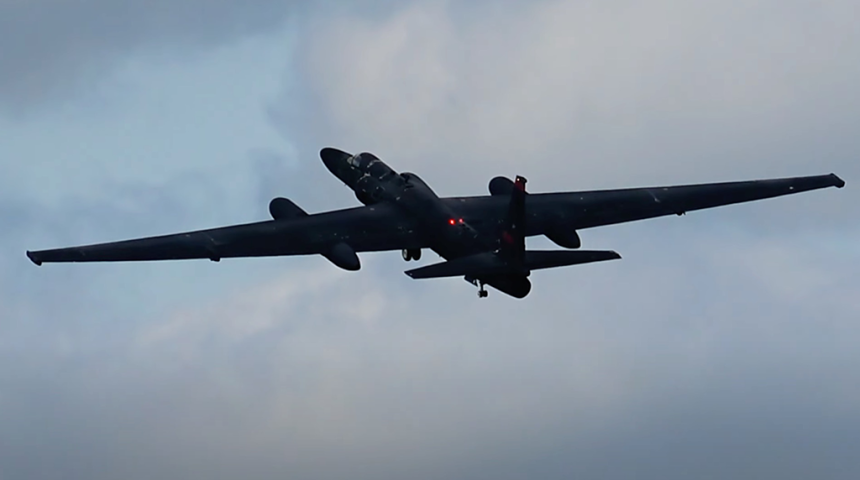Let’s have a look at this interesting video of five U-2 Dragon Lady take offs in different configurations and weather conditions.
Based at Beale Air Force Base, California, home of the 9th Reconnaissance Wing, but regularly deployed to Forward Operating Locations across the world, the U-2 Dragon Lady is an almost legendary asset. First flown in 1955, only 104 U-2s were built. The U.S. continues to operate the in their intended ISR (Intelligence Surveillance Reconnaissance) role, although the Dragon Lady also serves as a developmental platform for several new projects.
As we explained it in an article we posted a few years back, when we had a chance to have a close look at the iconic spyplane, everything about operating the U-2 is remarkable. Its pilots, among the most skilled in any air force, wear an ultra-high altitude pressure suit that is effectively a spacesuit, including the large bubble-like helmet. Pilots must pre-breath pure oxygen for an extended time prior to their high-altitude surveillance missions, the time varying depending on the duration of their mission. Long missions can last a staggering 10+ hours. The pilots also wear radiological dosimeters to record the amount of solar radiation they are exposed since they fly at the outer limits of the atmosphere and are exposed to higher levels of harmful radiation from the sun.
During periods of elevated sunspot activity, the pilots do not fly high altitude missions. Pilots eat pureed paste-like food through a tube during long missions. If a pilot has to urinate during a mission, they do so into a flexible bladder sewn into the suit. If they have to defecate, something avoided through careful management of diet in the days prior to a long-range, high-altitude flight, the suit is no longer useable. Once the helmet is donned and the pilot is ready to fly, they can’t even scratch an itch on their face.
The U-2 is, among all the other things, a quite difficult aircraft to fly. Almost all the aviation enthusiasts know that the iconic intelligence gathering aircraft requires some special landing assistance by chase car driven by experienced pilot who assist their colleagues aboard the U-2s.
Chase automobiles are used to supervise take offs, landings (and touch and gos) wherever U-2 Dragon Lady pilots bring their planes. Such cars are driven by highly trained pilots who are in contact with and act as ground-based wingmen for the pilot aboard the spyplanes: they call out the residual altitude to touchdown and wing attitude, and provide general assistance by radio talkdown. In fact, the U-2 is very difficult to land: its shape is such that the pilot’s view is obstructed by the airframe and there’s also a significant risk of hitting any ground obstacle with a wingtip. Furthermore, the bicycle configuration of the landing gear, with a forward set of main wheels located just behind the cockpit, and a rear set located behind the engine, along with the need to drop a wingtip to the ground (on titanium skidplates) to come to a halt, make landings extremely difficult.
Then, once the plane stops, it requires the “pogos”, removable support wheels, that are installed to keep the wing balanced when the aircraft taxies to the parking. Fit into sockets underneath each wing at about mid-span the pogos are, obviously, installed also for take-offs: they allow the U-2 to taxi to the runway and fall off during the take off roll.
The video below shot by our friend @Saint1Mil shows it pretty well. You can see the pogos, the red metal sticks with small wheels, that fall off as the aircraft performs its take off roll. But there’s much more than that. The footage is particularly interesting as it allows you to compare the length of the take off roll as well as the subsequent steep climb of the Dragon Lady out of RAF Fairford, UK, in different configurations. For instance, the non-mission airframe, takes around 8 seconds to get airborne from the beginning of the take off roll. The mission frame, with more fuel and additional sensor package requires almost twice that time (15 seconds) that is still less than many aircraft of comparable size.
Interestingly, the mission-equipped airframes carry the ASARS-2 (Advanced Synthetic Aperture Radar System) under the extended radome on the nose that allows the aircraft to catch high-fidelity radar imagery of the battleground out to about 100 miles on either side of the aircraft’s position; the huge Senior Span or Senior Spur dorsal pod, that houses an uplink antenna for satellite communication that allows the U-2S to beam its intelligence (data or imagery) back to any location BLOS (Beyond Line Of Sight) in near to real-time; and the wing-mounted “Senior Glass” superpods housing intelligence gathering sensors.
BTW, if you are interested in the U-2 Dragon Lady, you can listen to this +2-hour live interview with did with Ross Franquemont, a former Dragon Lady pilot, in September 2020:









